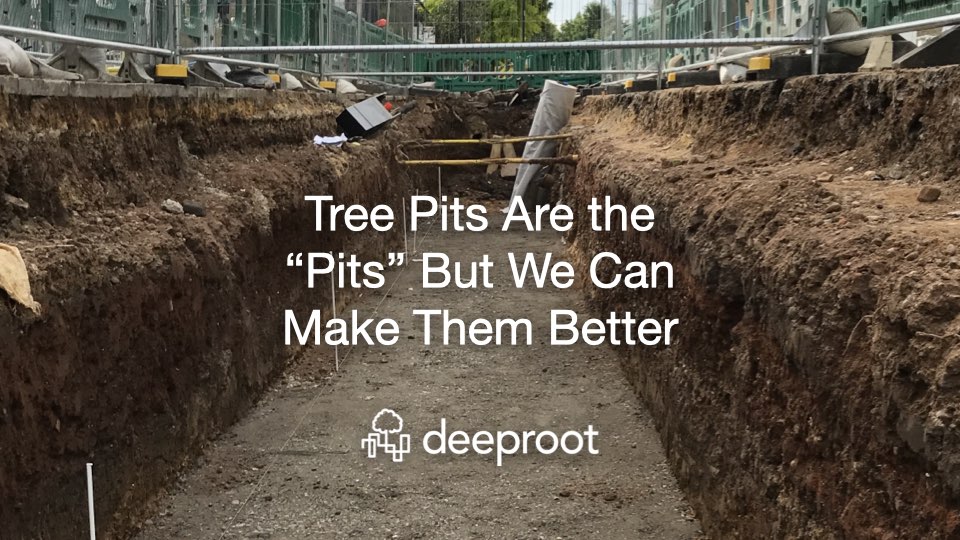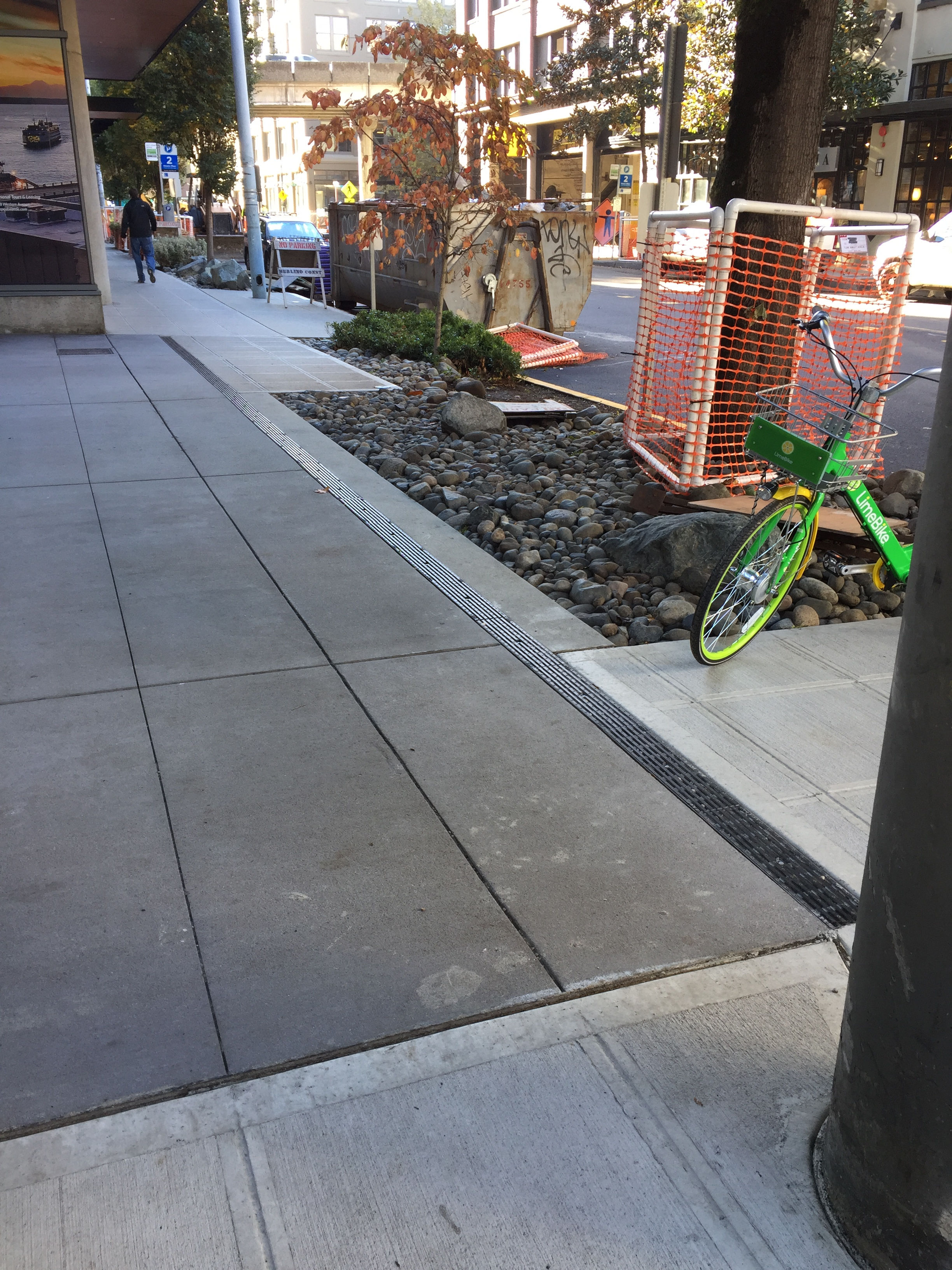by Peg Staeheli, PLA FASLA, MIG|SvR
Many cities have a long history of tree planting campaigns. However, in order to reap the benefits for health and habitat, we need to continue to help urban trees thrive long after they’re planted. Let’s consider ways we might improve conditions for trees along our streets.
Tree pit design — the space and conditions for planting trees in hardscape zones — is improving. Still, there are many trees barely surviving in constrained tree pits and within grated surfaces. Retrofitting tree pits to improve conditions for these trees and allowing them to grow past their typical 15-year urban life requires additional analysis, tools, and techniques.
Urban street corridors and plazas must compete for use of space to accommodate sidewalks, benches, awnings, signs, utility poles, underground utilities, and trees. It’s easy to understand, then, why urban designers have in the past installed trees in tiny 4’x4’ “tree pits.” We now know that these trees did not thrive and a high percentage were removed or replaced within several years.
Today, best practices allow more room for trees to prosper. We aim to provide three-dimensional room for our urban trees below grade, at the surface, and in the air above. But what can we do about all those trees currently being strangulated in tree pits? Luckily, as interest in walkable neighborhoods and commercial districts increases, we are seeing a change in attitude toward retrofitting for urban tree health rather than simply removing trees.
A key step in assessing individual and contextual tree needs involves field review of the trunk flare and surficial roots, width of pedestrian passing area, grade, pavement conditions within surrounding hardscapes, adjacent curb lane use, and nearby utilities and structures. Each of these elements impacts potential modifications to improve the space available (surface area and soil volume), adjacent grades, and surface treatments for existing trees. Once the field assessment has taken place, appropriate solutions can be identified.
Best Practices in Retrofitting Tree Pits
Space: Increasing the surface area of an existing tree pit is the first and most obvious step towards improving conditions around trunk flare and large surface roots. Depending on context, we recommend expanding the tree pit to the point where there is roughly 6 feet of adjacent pedestrian clear space. While you can further reduce this space to 4 feet, we would encourage you to be cognizant of both pedestrian traffic volume and the length of this tighter pedestrian zone. Typically 6 feet allows two people to comfortably walk beside each other or, more importantly, for walking with a person using a mobility device such as cane or walker, or wheel chair. (Refer to national accessibility standards, such as PROWAG in the US, as well as local requirements, for specific minimums). If space is tight look to the length of the tree pit to add more room. Increasing a tree pit opening to at least 8 or 10 feet long can provide area for more water and air to penetrate the substrate feeding the tree roots. Shallow saw cutting of the existing hardscape area and then chipping out and removing the pavement with hand tools is the safest way to avoid damaging the roots.
Grade: It is not unusual to find that the tree is either sitting too low or too high compared to the surrounding hardscape. Often this was intentional at planting. If the tree is sitting higher than the surrounding hardscape there may be an opportunity to raise the adjacent curb and/or hardscape to allow for placement of soil over exposed roots. Providing even a few additional inches may be enough to add soil. Another option when reviewing grades is to employ the use of an airspade to loosen soils and possibly encourage roots to resettle lower.
If a tree pit is lower than the surrounding hardscape, expanding the tree pit may allow transition fill to provide a more gradual blend to the existing ground surface. Use of free draining soil or even pea gravel or another open-graded aggregate may be an option to provide transition grades in these conditions.
Finally, there may be instances where the roots have uplifted the pavement alongside the tree. In these situations, changing the grade nearest to the tree pit with a longer grade transition, allowing room for hardscape to rise up over root areas then back down, should be considered as tree pit widening occurs. (Again, refer to national and local accessibility standards for maximum grades and lengths for slopes in public and private open space. Generally, aim to keep maximum slopes under 5% for pedestrian travel routes).
Adjacent uses: When enlarging tree pit areas, adjacent uses should be considered. If there are parking areas alongside the tree pit, we suggest 8 to 10 feet in pit length. Do not exceed 12 feet unless there is accommodation for crossing the planting zone. If the tree pit comes up against a mobility curb ramp, we suggest the edge be curbed if there is not room to accommodate the ramp wing. Adjacent utility structures should be accommodated by raising lids to meet grades or adjusting the tree pit dimensions to accommodate the structure either within the pit or completely outside the tree pit.
Surface treatment: Following the retrofit of the tree pit, a decision should be made regarding the surface covering and whether wood chips, stone, gravel, or other material will be used. In commercial areas it is best to discuss tree pit surface treatments with the municipality. In mixed use areas or plazas, the type of treatment may depend on the party responsible for maintenance.
Retrofitting tree pits can result in almost immediate improvements as the conditions appear cleaner and well cared for and the additional opening may allow for some small plantings at the edges to freshen the space. In a season or two you should see signs of happier trees through growth and color. If you listen closely when the wind blows, you may even hear them say thanks.







Leave Your Comment